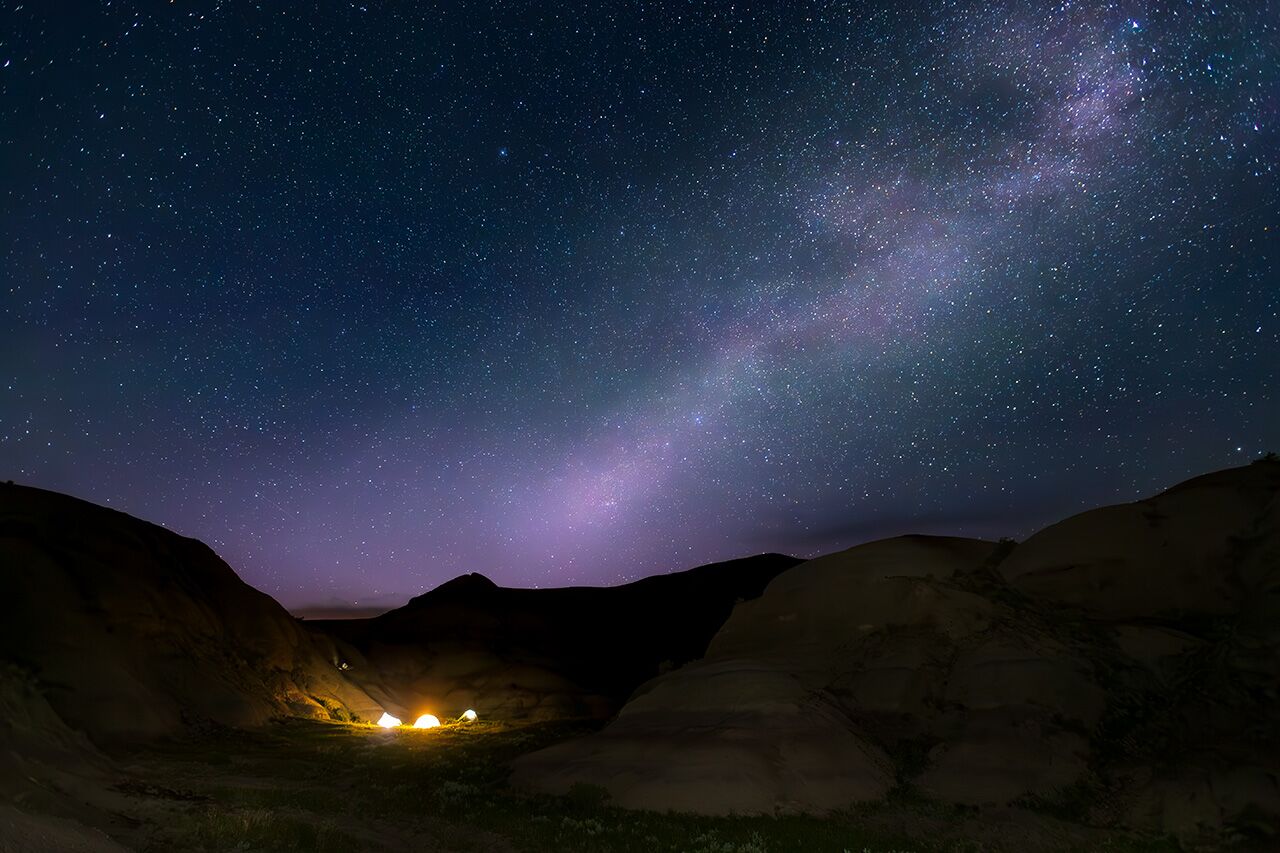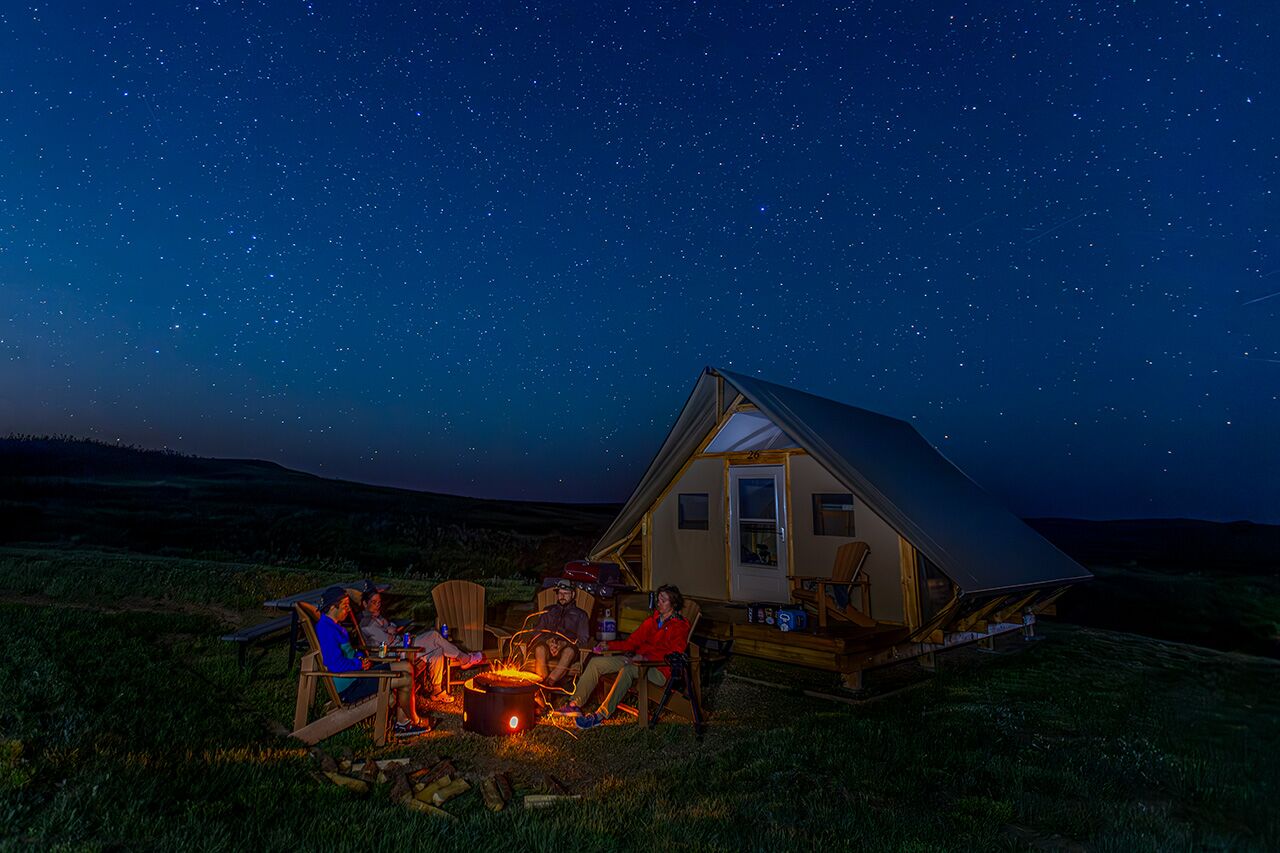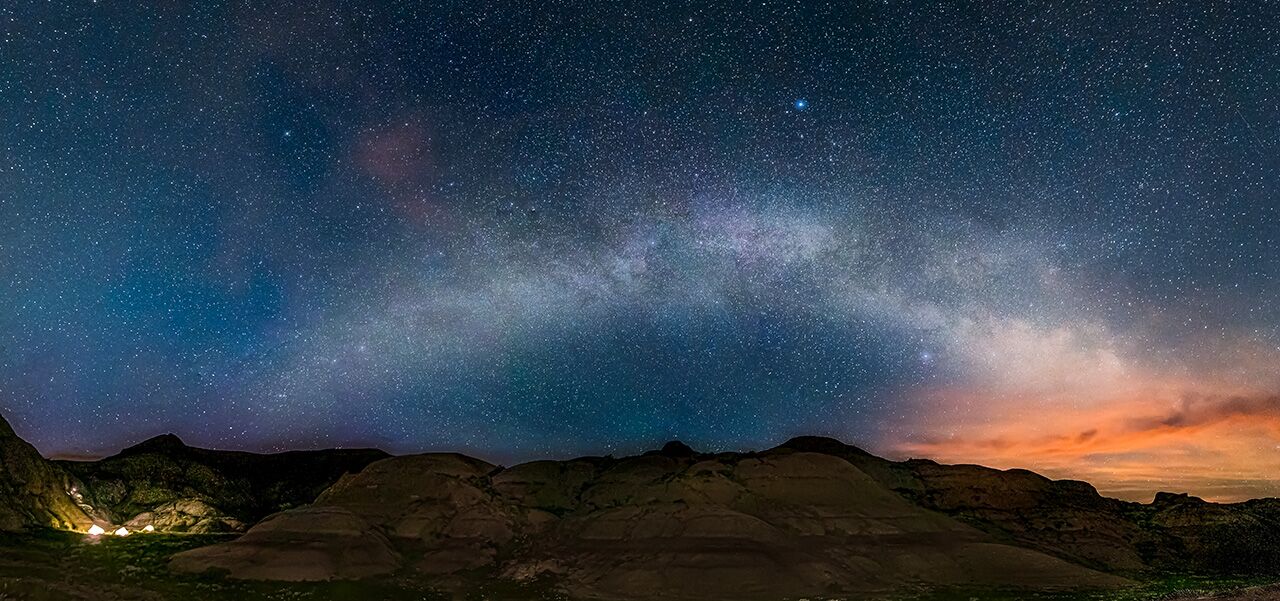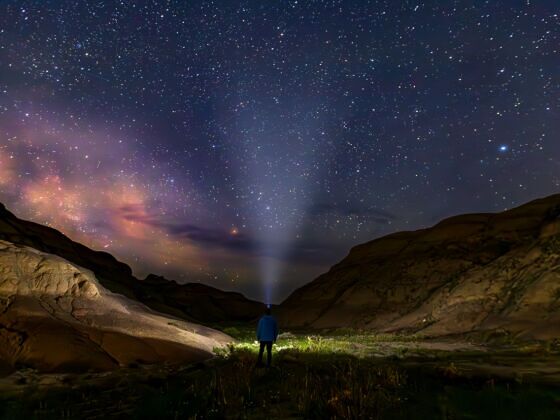Astrophotography is a fancy term for taking photos of the night sky. Originally developed for scientific purposes, these days it’s for everyone — yep, even amateurs with a smartphone or a simple point-and-shoot camera can photograph the stars. We have some tips on how to take decent photos with simple equipment at the end of the article, but just as important as kit and technical know-how is finding the right place. One of the biggest obstacles to obtaining good photos of the night sky — along with atmospheric turbulence, dust particles, and moisture — is light pollution. This is where Dark Sky Preserves come in!
A Dark Sky Preserve is a designated park that’s located far enough from any artificial light pollution to create the best circumstances for viewing — and snapping — the night sky. There are several such parks spread across Canada, and two of the finest lie in Saskatchewan, a province famed for its expansive natural attractions and wide-open skies. Visitors flock here to experience the Churchill River — used by local First Nations as a travel and trade route and these days for whitewater rafting and angling — as well as spots like Prince Albert National Park, the healing waters of Little Manitou Lake, the cultural education available throughout Wanuskewin Heritage Park, and Milton Lake Lodge, a fly-in fishing destination.
But the two key places for astrophotographers are Cypress Hills Interprovincial Park and Grasslands National Park. Read on for more on these two incredible sites.
Cypress Hills Interprovincial Park Dark Sky Preserve

Photo: Tourism Saskatchewan
The first park to become fully recognized as a Dark Sky Preserve in North America (in 2004), Cypress Hills Interprovincial Park is not to be confused with the popular rap group of a similar name. In fact, it’s named for the Cypress Hills that soar above the surrounding terrain, which — along with the scenic cliffs, lush forest, and prairie grasslands — make it one of the biggest attractions in the region.
Today, it’s a go-to destination for campers, anglers, hikers, ziplining fans, paddleboarders, kayakers, and mountain bikers (there are more than 50 kilometres — 31 miles — of trails). And in winter, it’s a snow-covered wonderland open to cross-country skiing and snowshoeing, tobogganing and lake skating, ice fishing, and more. Among the 220 species of birds, 47 species of mammals, and several species of reptiles and amphibians, you might well spot elk, moose, deer, and pronghorn.
For budding astrophotographers, the 400-square-kilometre (close to 250 square miles) Dark Sky Preserve offers superb observing conditions. In fact, it has some of the darkest and most easily accessible night skies in North America, with less than 60% nocturnal cloud cover in April and May, and under 30% during summer. The West Block Wilderness Area is the darkest section of the park, with popular photo areas including the hills and plateaus on the Alberta side and at historic Fort Walsh. But the main viewing area is at the park’s official Dark Sky Observatory, which runs public programming in the summer.
Cypress Hills need-to-know info
- Directions: The Dark Sky Preserve is accessible from the Trans-Canada Highway. Exit onto Highway 21 south toward Maple Creek and drive 39km (about 24 miles) to Highway 221, then head west into the Centre Block. Highway 21 also connects the park to the U.S. border, north of Havre, Montana.
- Camping and accommodations: The park has several campgrounds that range from basic to full-service and include an equestrian campground with corrals in the West Block wilderness area. Winter camping with yurts is also possible. Visit the Saskatchewan Parks reservation site to book. For something a little more upscale, The Resort at Cypress Hills has a hotel, townhouses (with fireplaces), rustic cabins, and an onsite restaurant — as well as a campground, gym, and yoga and fitness studio.
- Events: The Dark Sky Observatory and Dark Sky Campground at Cypress Hills Interprovincial Park host an annual Saskatchewan Summer Star Party in August — it’s one of the largest stargazing events in the country. Public programs and special astronomy events are also held at the Dark Sky Observatory during July and August.
Grasslands National Park Dark Sky Preserve

Photo: Tourism Saskatchewan
The Grasslands National Park Dark Sky Preserve, established in 2009, is even bigger than Cypress Hills at a whopping 730 square kilometres (approximately 282 square miles) spread across two separate blocks (East and West). It also offers a compelling mix of star-filled skies and nocturnal wildlife; its grassy hills and river valleys are populated by bison, owls, eagles, antelope, and black-tailed prairie dogs. Activities include visiting an archeological dig, riding horses with a bona fide cowboy on the open range, and enjoying the park’s many trails.
For night-sky snappers, the park is located in an area with pristine sky of Bortle Scale Class 1, meaning Grasslands has the best sky quality for astrophotography. According to the park’s website, in 2017, a naked eye magnitude of 8.4 was recorded where the “sky was so full of stars that the Milky Way could not be distinguished from the rest of the sky around it because there were so many stars!”
Access is allowed anywhere within the park at all hours, but popular spots for astrophotographers include the Two Trees Trail and Rock Creek Campground. Also check out the parking areas along the Badlands Parkway, which are accessible for cars, and the Belza House plateau near the Frenchman Valley Campground, which has a flat area for telescopes and provides spectacular views of the park and valley.
Grasslands National Park need-to-know info
- Directions: Grasslands National Park is located in southwest Saskatchewan near the border with Montana. There are two main entrances: the West Block and the East Block, each offering unique landscapes and experiences. When booking your campground, double check to ensure you select the correct entrance, as they have separate facilities and amenities. West Block is approximately 150 km (93 miles) south of Swift Current. East Block is around 215 km (133 miles) south of Moose Jaw.
- Camping: The park has an array of camping options, including tent and RV camping, backcountry camping, and the unique comfort of an oTENTik (a cross between a rustic cabin and a tent). Reservations are required, along with a valid Parks Canada Park Pass.
- Events: In partnership with contracted astronomers and speakers from the Regina and Saskatoon Royal Astronomical Society of Canada (RASC) Centres, the park holds major astronomical events (including Beyond the Big Dipper events), and interpreters regularly host astronomy outreach sessions on their own. Information on upcoming events can be found on the park’s website.
Astrophotography tips

Photo: Tourism Saskatchewan
The good news is that anyone with a camera or smartphone can partake in astrophotography. The not-so-good news is that it can, and probably will, require some practice and patience to get superlative results. However, given the beauty of these destinations, it can only be fun trying!
Add to your kit
- Several items can assist in producing satisfying results, but the only real essential is a stable tripod. Photographing the night sky requires long exposures, which means the shutter is open for a long time recording not only light but any incidental vibrations. No matter how steady you think your hands are, a tripod will prevent your photos from being ruined by camera shake.
- Another useful investment for the same reason is a remote shutter release. This is a cable that allows you to open the shutter remotely and avoids introducing the camera shake that can occur when you press and release the shutter button on the actual camera. That said, most cameras (and phones) come with a delayed shutter timer setting, which will also work fine, as will utilizing your phone’s built-in voice assistant.
- Consider a headlamp so you can keep your hands free to use the camera. If possible, get one with a red light mode, which won’t throw off your night vision once your eyes have adjusted to the dark.
- You might also want to download an app such as Star Walk (for iPhone) or the free Google Sky Map (for Android), which show the view from specific places at any time of the night.
Technical know-how
- The first technical step is to put your phone or camera in manual mode so you have full control over shutter speed, aperture, and ISO. Make sure your focus is on manual, too — the night sky is too dark for most sensors to focus on. Smartphones should be in Night Mode; if yours doesn’t have that option, apps such as Camera+ 2 for Apple and Camera FV-5 for Android can help.
- Set your phone or camera to record RAW image files, which will capture much more data to play with than JPEG files, which are automatically compressed. This is especially important if you’re planning to post-process or stitch together images using computer software after the shoot.
- You’ll want to set your aperture as wide as possible — ideally f/2.8 or lower but generally just the lowest number your lens is capable of. You’ll also need your ISO (which registers light sensitivity) to be as high as possible, though do check to see how grainy this makes your images. Some sensors can create unwanted noise at high ISO levels, and since the actual level differs vastly from model to model, it’s important to find out the sweet spot for whatever camera you’re using.
- To focus your camera, choose the patch of night sky or scene you want to capture, and select the most prominent light source in the sky — i.e., the brightest star — and zoom in. Adjust the focus until that element becomes as sharp as possible. Next, set your shutter speed to around 30 seconds and click away. You’ll need to keep checking the results to get the correct exposure; if it’s too dark then you need a longer exposure. Adjust the ISO if too grainy, and the focus if not sharp enough. Repeat until you have the results you want!
- For more in-depth tips, check out this expert astrophotography guide.
Don’t forget to bring warm clothing and/or a blanket, and perhaps a camping chair, so you can relax in comfort and enjoy the view with your own two eyes while you wait for your camera to do the work. And tag your winning images with #ExploreSask when you post online. Good luck!

